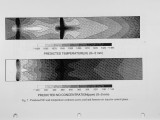| OCR Text |
Show surprising, as both are indicators of coal rank and are inter-related. A surprising finding is that nitrogen has the least influence on N O reduction. The reason for this may be to the fact that if w e assume a more or less uniform distribution of fiiel-nitrogen between volatile matter and char [21], the benefit from volatile-N (mainly as H C N reducing N O to N2 ) in the rebum zone will be largely offset by char-N which is released as NO during burnout. The consequent effect of coal-N will be small and, depending on specific conditions and coal devolatilisation behaviour, there may be a net positive or negative production of N O . 4.2 Modelling Studies Figures 7 shows the typical cross-sectional predicted temperature and N O concentration profiles in the reactor. The interaction of the flow with the rebum coal and bum-out air injector jets are clearly demonstrated with the maximum temperatures and N O concentrations predicted to be on the central axis of the reactor. The results presented in the paper are based on analysing the data from this and similar predictions for the other coals and operating conditions. In particular the changes in temperature and concentration of important species along a path or streamline defined from the centre of the coal jet towards the centre of the reactor was investigated in detail. Some of these results are analysed and compared with the experimental observations in the following sections. Predicted effect of coal devolatilisation rates on NO reduction Measurements and predictions of coal burnout and furnace temperature compared in Fig.8 for Pittsburgh No.8 coal, show good agreement for the operating conditions shown. The temperature of the combustion products leaving the primary zone (Tpr) was 1300°C. The predicted axial N O concentration profile is compared with the experimentally measured values in Fig. 9. The predictions are based on a pyrolysis mass loss (Rv) of 1.1 and 1.32 times the coal proximate volatile percentage (on a dry, ash-free basis) [24]. The devolatilisation rate parameters for this coal were obtained from Badzioch and Hawksley [13] (A =5.0x105/s and E =17,700 cal/gmol K ) . Kinetic data for the char reactivity was taken from Hurt et al [25] using A =29.0 g m mol/(cm2 s atm°5, E =24.0 kcal/mol) and the ratio (moles-CO)/(moles-C02) given by 4.0x10^ exp(-30/RT). Figure 9 also compares the sensitivity of the predicted and measured N O concentration profiles for a selection of initial assumptions concerning the mechanism of N O reduction. 100 75 ~ 1 50 _. Z3 CD 25 - 0 1350 o O 1200 <D _. 3 2 g_ 1050 - E I- 900 0.0 0.5 1.0 1.5 2.0 2.5 Fig. 8 Comparison of measured and predicted furnace temperature and burnout for Pittsburgh No.8 coal, SR1 = 1.03, S R2 = 0.89, SR3 = 1.08, RF = 0.31, Tpr = 1300'C. |





















